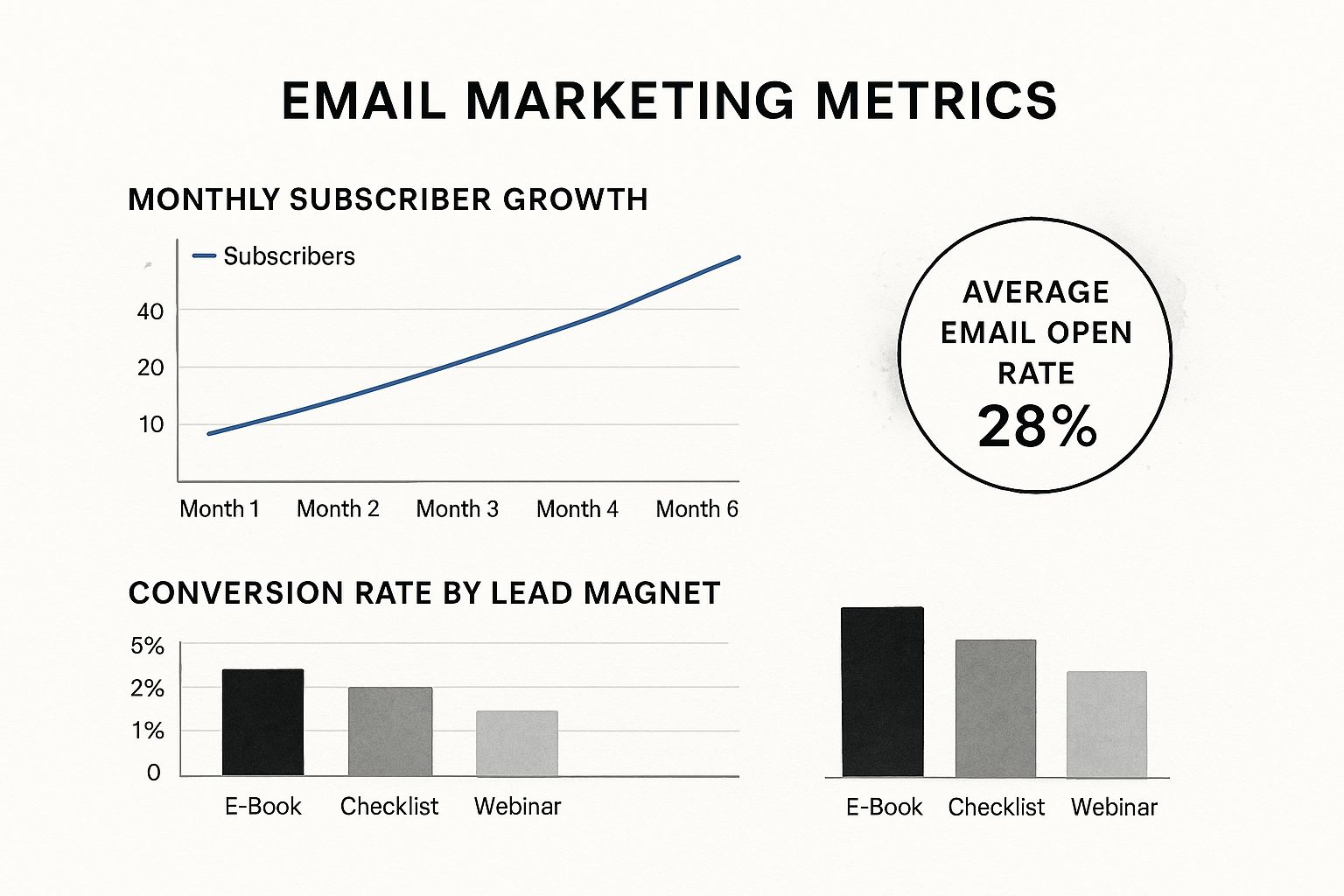- Grow Newsie
- Posts
- How to Start a Newsletter Business: Your Complete Guide
How to Start a Newsletter Business: Your Complete Guide
Learn how to start a newsletter business from industry experts. Discover proven strategies, tools, and monetization tactics that actually work.

The internet is overflowing with content. Creators, however, are finding it increasingly difficult to connect directly with their audience. Social media algorithms often prioritize engagement metrics, leaving creators at the mercy of platform changes. This makes building a loyal following and effectively monetizing content a real challenge. As a result, creators are looking for more dependable ways to reach their audience. This is where the newsletter business model shines.
The Direct Connection Advantage
Newsletters offer a direct line to your audience, bypassing the gatekeepers of social media. Imagine sharing your latest work, insights, or offers directly with people who are genuinely interested. This direct connection builds community and trust, leading to higher engagement and conversion rates than social media. This close relationship is what makes newsletters so appealing.
Monetization Opportunities With Newsletters
Newsletters offer several ways to monetize content and generate reliable income. Creators can offer premium subscriptions for exclusive content, partner with brands for sponsorships, or sell products or services directly to subscribers. But newsletters are more than just marketing tools. They help build a loyal community around your brand or expertise. This fosters deeper relationships and translates to long-term revenue.
Email newsletters have seen a phenomenal rise in recent years. The sheer volume of newsletters and emails sent reflects their growing popularity as a business model. For example, on the Beehiiv platform, the number of emails sent increased from 402 million between 2021 and 2022 to 4.5 billion in 2023. It then reached a massive 15.6 billion in 2024. This growth is particularly noticeable among independent creators and journalists seeking to connect directly with their audience. Learn more about email newsletter statistics here: https://blog.beehiiv.com/p/2025-state-of-email-newsletters-by-beehiiv
Thinking of starting a newsletter?
I’ve partnered with the beehiiv team to set you up with:
✅ 20% off your first 3 months
✅ A free 30-day trial, no credit card needed
It’s packed with features that make creating great content easier: AI tools that save time, landing pages that convert better, and a built-in ad network to help you earn more.
Beyond the Hype: A Fundamental Shift
The resurgence of newsletters isn't just a passing fad. It represents a fundamental shift in how people consume and pay for content. More and more, audiences are willing to pay for high-quality, curated information delivered straight to their inbox. This encourages creators to invest in building a thriving newsletter business. By consistently delivering value and building genuine relationships with subscribers, creators can build a sustainable and rewarding career.

A successful newsletter business starts with the right niche. This means finding a topic you know well and that has a market of interested readers. It's about connecting with an audience and meeting their specific needs. This is where your passion and potential for profit come together.
Identifying Untapped Opportunities
Finding a profitable niche often involves looking for untapped opportunities. Explore areas where existing newsletters aren't fully serving their audience. This could involve researching competitor newsletters and analyzing their content. By understanding the existing landscape, you can find gaps in the market and position your newsletter uniquely.
Understanding Audience Pain Points
Understanding your audience's pain points is equally important. What problems are they facing? What information are they looking for? By addressing these pain points, you provide real value to your subscribers. This not only attracts new readers, but also builds a loyal following who are more likely to become paying customers.
Passion Meets Profitability
Long-term success hinges on finding the right balance between passion and profitability. While genuine enthusiasm is important, it must be paired with a sound business model. Ask yourself: are people willing to pay for information in this niche? This is key to building a successful newsletter business. The ever-growing global email user base provides a large potential audience. In 2025, nearly 4.5 billion people used email worldwide, a number expected to exceed 4.8 billion by 2027. This offers huge opportunities to connect with a wide audience. For more statistics, check out this resource: Email Marketing Statistics.
Testing and Validation
Before fully committing to a niche, test and validate your idea. This could include conducting surveys, running small experiments, or gathering feedback from potential subscribers. Validating your niche early on saves time and resources, setting a strong foundation for your business. This research helps refine your content strategy and build a newsletter that truly resonates with your target audience.
Your platform choice significantly impacts your newsletter business. Careful selection is crucial. Choosing the right tools and platform from the start can be key to your success. This means understanding how successful newsletter creators choose their resources. We'll examine essential features for growth and monetization. This helps you avoid hidden costs and limitations. We’ll also look at automation, a key difference between profitable newsletters and amateur efforts.
Key Features to Consider
Effective platforms offer features that simplify your work and maximize your reach. These features separate the best platforms from the rest. Here are some essentials:
Email Deliverability: Ensure your emails land in inboxes, not spam folders. High deliverability rates are essential for reaching your audience.
Segmentation and Personalization: Send targeted content to specific subscriber groups to increase engagement. Personalization leads to better open and click-through rates.
Automation: Automate email sequences, welcome messages, and other repeated tasks to save you time. This lets you focus on creating great content.
Analytics and Reporting: Monitor key metrics like open rates, click-through rates, and subscriber growth to refine your approach. Data-driven decisions are essential for growth.
Monetization Integrations: Connect easily with payment systems and other tools for subscriptions and other income streams. Simple monetization options are key for profits.
Evaluating Platform Options
Many platforms suit various needs and budgets. Each has its own features and advantages. Keep these in mind when deciding:
Pricing: Compare pricing tiers and select a plan that fits your budget and expected growth. Understanding pricing is important for your budget.
Scalability: Choose a platform that can handle increasing subscribers as your audience grows. Scalability lets your platform grow with your business.
Customer Support: Reliable support is vital for fixing technical problems and getting help when you need it. Good support saves you time and effort.
User Experience: An easy-to-use platform with a clear interface simplifies your workflow. A user-friendly interface makes your work easier.
To help you evaluate your options, let’s take a look at a comparison of a few popular platforms:
Newsletter Platform Comparison: Comprehensive comparison of top newsletter platforms including features, pricing, and best use cases
Platform | Monthly Cost | Key Features | Best For | Deliverability Rate |
|---|---|---|---|---|
Free, 5% transaction fee for paid newsletters; 10% transaction fee for Substack Reader | Easy setup, built-in payments, community features | Writers, independent creators | Varies, generally reported as good | |
Revue (by Twitter) | Free, 5% transaction fee for paid newsletters | Simple interface, Twitter integration, curated content | Businesses, organizations | Varies, generally reported as good |
Starting at $29/month | Advanced automation, landing pages, email sequences | Professional bloggers, marketers | High, typically above 98% | |
Free for up to 500 contacts, paid plans starting at $11/month | Comprehensive features, e-commerce integrations, A/B testing | Businesses of all sizes | High, typically above 98% |
This table highlights some key differences in pricing, features, and ideal user types. Remember to research based on your specific needs.

This infographic shows key data for a sample newsletter business. It includes subscriber growth over six months, conversion rates for different lead magnets (e-book, checklist, webinar), and the average email open rate. Subscriber growth is positive, with the e-book performing best as a lead magnet. The average open rate suggests good engagement with the email content. This shows how important a strong content strategy and choosing the right lead magnet are for newsletter success.
Essential Tools For Success
Besides your platform, other tools can improve your newsletter operation. They complement your platform and enhance your overall workflow:
Email Marketing Service Providers: For larger lists, providers with advanced features and better deliverability might be a good fit. This is crucial for reaching your audience.
Writing and Editing Tools: Improve your writing with grammar checkers, plagiarism detectors, and editing software. Good writing builds trust.
Graphic Design Tools: Create visually appealing graphics and templates for your content and promotions. Eye-catching visuals improve reader engagement.
Social Media Management Tools: Schedule and manage your social media posts to bring traffic to your signup page. Social media can significantly expand your reach.
By evaluating your needs and selecting the right tools and platform, you’re setting yourself up for a thriving newsletter business. This planning is key for long-term success.
Creating Content That Subscribers Actually Crave

High-quality content is the cornerstone of any successful newsletter. It's not about churning out emails just to fill inboxes. It’s about crafting messages your subscribers genuinely anticipate. This involves understanding what your readers find valuable and how they think. Let's explore these crucial aspects.
Developing Your Authentic Voice
Your authentic voice is what makes you stand out. It's the unique perspective and style that connects with your audience. Imagine two newsletters about personal finance. One uses a formal, academic tone. The other offers friendly, relatable advice. This difference in voice can significantly impact how subscribers engage with the content. Finding your voice takes experimentation and refinement. Consider your target audience and the overall tone you want to project.
Delivering Consistent Value
Beyond an engaging voice, consistent value keeps subscribers hooked. Think of your newsletter as a subscription service. People expect something valuable in return for their time. This could be expert insights, helpful resources, exclusive deals, or a unique combination. Check out this guide on How to Master Newsletter Content Strategy. Consistent value builds anticipation and reduces the number of people who unsubscribe. This results in a stronger, more engaged readership.
Proven Content Frameworks
Several content frameworks can boost engagement. Curation, where you gather and share the best resources on a topic, can save your subscribers time and position you as a valuable source. Original analysis, offering your unique perspective on trends or events, gives readers fresh insights. A Q&A format, addressing reader questions or interviewing experts, creates a sense of community. Experiment to see what works best for your audience. This keeps content fresh and engaging.
Structuring for Maximum Impact
How you structure your newsletter affects its readability. Using clear headings, short paragraphs, and bullet points makes the content easy to digest. Think about the last time you opened a cluttered email. Did you read it all? Probably not. Most people scan emails, so make key information easy to find. This also means using calls to action strategically. Make it clear what you want subscribers to do, whether it's visiting a link, buying a product, or answering a question. A clear structure improves the chances of your message being read and acted upon. By mastering these techniques, you'll make your newsletter a must-read, solidifying your position as a leader in your field.
Building Your Subscriber Base From Zero to Thousands
Growing a newsletter business from your first subscriber to a thriving community takes strategy and consistent effort. Attracting your initial audience is just the first step. Scaling to thousands of engaged readers requires a different approach. This means understanding effective strategies, learning from real-world successes, and adapting your approach as your newsletter evolves.
Attracting Your Initial Subscribers
Starting from scratch can feel daunting. However, several proven methods can help you gain traction. Lead magnets, such as offering a free e-book, checklist, or webinar in exchange for an email address, are highly effective. Think of it as offering a valuable sample of your newsletter's content.
For example, if your newsletter focuses on productivity tips, offer a free checklist for optimizing your workday. Additionally, running contests or giveaways can create buzz and attract new subscribers.
Scaling Your Growth: Organic Strategies
Once you have an initial base, organic growth strategies become crucial for sustained expansion. Implementing a referral program, where existing subscribers are rewarded for bringing in new readers, can be powerful. This leverages the power of word-of-mouth marketing.
Furthermore, strategic partnerships with other newsletters in complementary niches can expose your content to a wider audience. This is like cross-promotion, benefiting both partners.
Leveraging Paid Growth Strategies
While organic growth is important, paid advertising can accelerate your subscriber acquisition. Platforms like Facebook, Twitter, and LinkedIn allow you to target specific demographics interested in your niche. This allows you to reach a larger audience more quickly.
However, it’s important to allocate your budget wisely and track your results closely. This ensures you’re getting a return on your investment. You might be interested in: How to master growing your newsletter subscribers.
Optimizing the Subscriber Journey
Every interaction a potential subscriber has with your newsletter matters. A compelling landing page dedicated to sign-ups, with a clear value proposition, is essential. This is the first impression many potential subscribers will have, so make it count.
Also, using social media strategically can drive traffic to your landing page. However, avoid becoming overly reliant on any single platform. Diversifying your promotional efforts across various channels mitigates the risk of algorithm changes impacting your reach. This allows you to maintain a consistent flow of new subscribers.
By combining these strategies and adapting them to your specific niche, you can build a thriving newsletter business with thousands of engaged readers. This requires continuous learning, experimentation, and a commitment to providing valuable content. Remember, building a successful newsletter is a marathon, not a sprint. Consistent effort and strategic thinking will ultimately lead to long-term growth and success.
Building a successful newsletter goes beyond simply creating great content. It requires a solid monetization strategy to transform your passion project into a sustainable business. This means understanding how successful newsletter entrepreneurs generate consistent revenue. We'll explore various income streams, including premium subscriptions, strategic sponsorships, and direct product sales. This involves understanding pricing strategies, attracting the right brand partners, and creating premium content that subscribers are happy to pay for.
Premium subscriptions offer a compelling way to monetize your newsletter. They provide exclusive content to paying subscribers, which could include in-depth articles, early access to new material, exclusive community access, or personalized advice.
For example, an investment strategies newsletter might offer premium subscribers a detailed monthly market analysis unavailable to free subscribers. This added value justifies the subscription cost. Effectively pricing your premium subscriptions involves researching what similar newsletters charge and understanding the perceived value your content offers. Setting the right price is crucial for attracting subscribers without undervaluing your work. Consider resources like How to master making money with a newsletter for guidance.
Strategic Sponsorships: Partnering With Relevant Brands
Sponsorships offer another valuable revenue stream. This involves partnering with brands relevant to your niche. Instead of simply running ads, consider organically integrating sponsors into your content.
For example, you could feature a sponsored product review or mention a brand's service within a relevant article. This approach feels less intrusive than traditional advertising, preserving subscriber trust. Attracting quality brand partners requires showcasing your newsletter’s value, including highlighting subscriber demographics and engagement metrics. Clearly demonstrating your audience's relevance to potential sponsors increases your chances of securing lucrative partnerships.
Product Sales: Offering Tangible Value
Selling products or services directly to your subscribers is another effective monetization avenue. These offerings should align with your newsletter’s focus and provide tangible value to your audience.
Consider creating an e-book, online course, or toolkit that expands upon topics covered in your newsletter. This approach provides a natural extension of your content and offers subscribers a deeper dive into areas of interest. Successfully selling products requires understanding your audience’s needs and creating products that directly address them. This ensures your offerings resonate with subscribers and generate strong sales.
To help you choose the best monetization strategies, we've compiled a table summarizing different approaches:
To help you choose the best monetization strategies, we've compiled a table summarizing different approaches:
Newsletter Monetization Strategies
This table outlines various revenue streams, implementation timelines, and expected earning potential for different newsletter monetization methods.
Strategy | Subscriber Threshold | Revenue Potential | Time to Implement | Difficulty Level |
|---|---|---|---|---|
Premium Subscriptions | 500+ | Moderate to High (depending on pricing and subscriber base) | 1-2 Weeks | Medium |
Strategic Sponsorships | 1000+ | Low to High (depending on niche and sponsor relationships) | 2-4 Weeks | Medium to High |
Product Sales | 500+ | Moderate to High (depending on product pricing and demand) | 4-8 Weeks | High |
This table provides a general overview. Actual results can vary based on several factors, including niche, audience engagement, and marketing efforts. Focusing on strategies that align with your audience and content is crucial for maximizing revenue potential.
Avoiding Common Monetization Mistakes
While monetizing is crucial, avoid mistakes that damage your subscriber relationships. Overly promotional content or irrelevant sponsorships can erode trust and lead to unsubscribes.
Finding the right balance between monetization and providing valuable, non-promotional content is key. Remember, your subscribers are your most valuable asset.
Optimizing Your Revenue Mix
Testing different monetization strategies and finding the optimal mix for your newsletter is essential for long-term success. This involves analyzing your revenue streams and adjusting your approach based on subscriber feedback and market trends.
Some newsletters thrive primarily on premium subscriptions, while others find a combination of sponsorships and product sales more effective. Finding the right balance is an ongoing process. By implementing these strategies and continuously optimizing your approach, you can build a profitable and sustainable newsletter business. This creates a venture that provides both valuable content to your subscribers and consistent income for yourself, combining passion and profit.
Once you've established your newsletter and built a loyal readership, scaling for long-term success is the next step. This means thinking strategically and implementing systems for continued growth. Understanding how successful newsletter creators automate tasks, streamline workflows, and maintain high standards as their audience expands is key. It's about ensuring your business can handle growth without sacrificing the quality that initially attracted your subscribers.
Automating For Efficiency
As your newsletter grows, so do the demands on your time. Automating repetitive tasks is crucial for efficiency. This includes automating email sequences, welcome messages, and other routine communications. For example, a welcome sequence could automatically deliver valuable content to new subscribers over their first week, nurturing their interest and setting expectations. Automating these tasks frees up your time to focus on content creation and strategic planning—the core elements of a thriving newsletter.
Building Efficient Workflows
Efficient workflows are essential beyond automation. This means having a clear process for everything from content planning and creation to email delivery and subscriber management. This might involve using project management software like Asana, editorial calendars, or other tools to organize your operations. A well-defined workflow ensures smooth operation and reduces the chance of errors or delays, especially as your team expands and the workload increases.
Maintaining Quality During Growth
Maintaining content quality as your audience grows can be challenging. Establish clear quality control measures and editorial guidelines. This might include having a second person review all outgoing content or using style guides to ensure consistency. This helps preserve the high standard of writing that initially attracted subscribers. Just as a chef maintains consistent dish quality regardless of restaurant size, consistent newsletter quality builds trust and strengthens your brand.
Metrics That Matter For Long-Term Health
Tracking the right metrics is essential for understanding your newsletter's performance and making informed decisions. While open and click-through rates are important, focus on metrics that reflect long-term health, such as subscriber growth rate, churn rate (the rate at which subscribers unsubscribe), and customer lifetime value. Understanding these metrics helps you identify areas for improvement and ensure sustainable growth. These metrics provide insights into the overall health of your newsletter business.
Avoiding Growth Tactics That Damage Subscriber Relationships
While growth is important, avoid tactics that damage subscriber relationships. Purchasing email lists, sending excessive emails, or using misleading subject lines might provide short-term gains but can ultimately erode trust and harm your reputation. Focus on building organic, sustainable growth by providing genuine value to your audience. A strong foundation built on trust is essential for long-term stability.
Advanced Strategies for Growth
As your newsletter matures, explore advanced growth strategies. Building a team can help scale content creation and marketing efforts. This could involve hiring writers, editors, or social media managers. Developing strategic partnerships with other newsletters or businesses in complementary niches can expose your content to new audiences, creating mutually beneficial growth opportunities. This can be a valuable way to expand your reach without compromising the personal connection that makes newsletters effective.
Creating a Growth Roadmap and Measuring Progress
Develop a clear roadmap for your newsletter's future. This involves setting SMART goals: Specific, Measurable, Achievable, Relevant, and Time-bound. For example, aim to increase your subscriber base by a specific percentage within a defined timeframe or launch a premium subscription tier with a target number of subscribers. Regularly measure your progress toward these goals and adjust your strategy as needed. A growth roadmap guides you on the path to long-term success.
By implementing these strategies, you can scale your newsletter business while maintaining the quality and personal connection that make newsletters so effective. Sustainable growth is built on providing consistent value to your subscribers and fostering genuine relationships with your audience.
